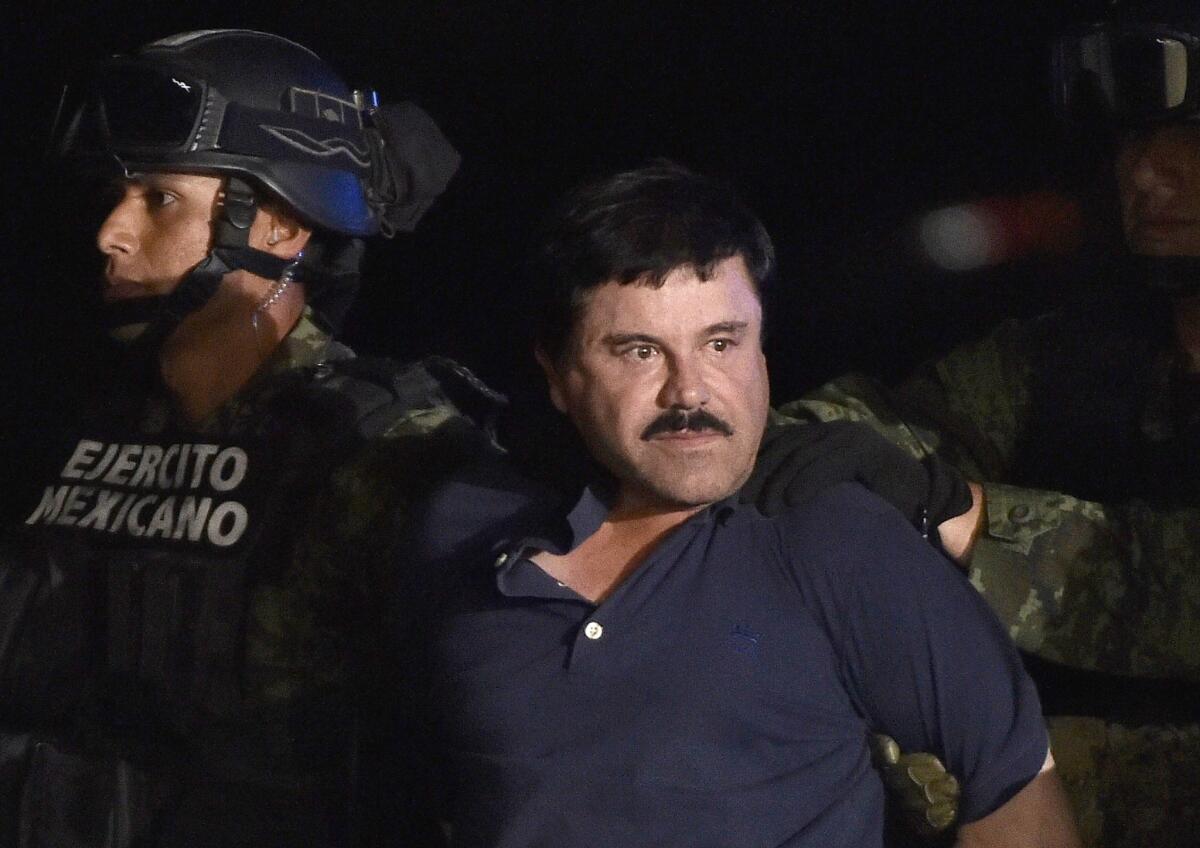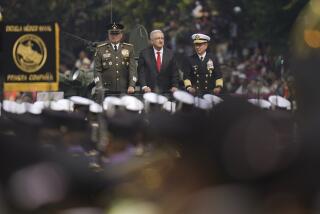How the case involving ‘El Chapo’s’ cartel illustrates the cycle of the drug trade

Drug kingpin Joaquin “El Chapo” Guzman is escorted to a helicopter at Mexico City’s airport on Jan. 8, 2016 following his recapture during an intense military operation in Los Mochis, in Sinaloa, Mexico.
reporting from SAN DIEGO — One woman agreed to launder drug money because she needed to pay her son’s college tuition.
A mother decided to drive a load of drugs across the border because her former husband had said the family would be threatened if she didn’t.
Both served small but necessary roles in a network that has helped Mexico’s powerful Sinaloa cartel smuggle and make a fortune off drugs, according to records filed in San Diego federal court.
An investigation of high-level Sinaloa associates launched in 2013 led to charges against more than 20 people accused of carrying out the grunt work for the cartel headed by Joaquin “El Chapo” Guzman — who was captured in Mexico on Friday, six months after he tunneled out of a prison.
The case illustrates the cycle of the drug business, from obtaining precursor chemicals in China to manufacturing the drugs in Mexico to smuggling them into the U.S. and laundering millions in illicit profits. The joint investigation by Homeland Security and the Drug Enforcement Administration was built on extensive wiretaps and electronic message intercepts. The allegations against most of those charged remain sealed and the identities of the top defendants secret.
The complaint does show, however, that the cartel used people like Esequiel Olivas Chaidez.
Olivas was a law-abiding citizen in Tijuana until his wife was diagnosed with breast cancer. To earn money, his lawyer said during a sentencing hearing Friday, Olivas helped the cartel by coordinating the import of 330 pounds of cocaine into the U.S., at a street value of $3.5 million.
U.S. District Judge Dana Sabraw sentenced Olivas to seven years in prison, saying the facts of the case indicated “deep involvement in a very horrific drug-trafficking organization.”
The cartel also used people like Iris Roberts, who was caught driving 16.5 pounds of meth into the country. She said in a sentencing memo that she had been pressured into the job.
Her former husband, Roberts said, had failed during a smuggling attempt and a trafficker was urging him to make up for the lost contraband. She got 30 months in prison.
And when drug proceeds needed to be laundered in the U.S., investigators said, the cartel turned to Romeo Alfonso Salguerio Retamoza.

Joaquin “El Chapo” Guzman, one of the world’s most powerful drug kingpins, gained folklore status during his decade-plus on the lam, evading authorities thanks to his skill at building secret tunnels from his assorted mountain hideouts, urban safe h
According to a search warrant affidavit filed in December, Salguerio was responsible for laundering millions of dollars, largely by having associates deposit sums of less than $10,000 into accounts throughout the country. Those amounts were then aggregated in banks in San Diego and transferred to Mexico.
Intercepts of Salguerio’s BlackBerry showed messages between him and Maria Zavala, who helped coordinate the deposits.
The former bank teller said in a sentencing memo that she needed the money to pay for her son’s tuition at UC Irvine. Zavala received a two-year prison sentence.
Salguerio, a Mexican resident who sometimes came into the U.S. on a visitor’s visa, was arrested in November as he crossed at San Ysidro.
Davis writes for the San Diego Union-Tribune.
MORE: Get our best stories in your Facebook feed >>
MORE ON “EL CHAPO”
White House questions Sean Penn role in drug kingpin case
‘El Chapo’ could have fled to another continent, but he chose to go home
Did Sean Penn do anything wrong in meeting with fugitive Joaquin ‘El Chapo’ Guzman?
More to Read
Sign up for Essential California
The most important California stories and recommendations in your inbox every morning.
You may occasionally receive promotional content from the Los Angeles Times.










